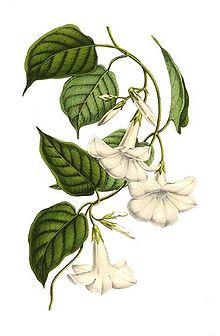- Mandevilla
-
Mandevilla 
Mandevilla suaveolens Scientific classification Kingdom: Plantae (unranked): Angiosperms (unranked): Eudicots (unranked): Asterids Order: Gentianales Family: Apocynaceae Subfamily: Apocynoideae Tribe: Mesechiteae Genus: Mandevilla
Lindl.[1]Species See text.
Synonyms Amblyanthera Müll.Arg.
Dipladenia A.DC.
Eriadenia Miers
Laseguea A.DC.
Mitozus Miers
Salpinctes Woodson[1]Mandevilla (
 /ˌmændɨˈvɪlə/)[2] is a genus of plants belonging to the family Apocynaceae, the Periwinkle family. It consists of about 100 species, mostly tropical and subtropical flowering vines.
/ˌmændɨˈvɪlə/)[2] is a genus of plants belonging to the family Apocynaceae, the Periwinkle family. It consists of about 100 species, mostly tropical and subtropical flowering vines.Mandevilla is native to Central and South America and many Mandevillas come originally from the Serra dos Órgãos forests in Rio de Janeiro, Brazil. The genus was named after Henry Mandeville (1773-1861), a British diplomat and gardener.[3]
Mandevillas develop spectacular flowers in warm climates. The flowers come in a variety of colours, including white, pink, yellow, and red. As climbers, Mandevillas can be trained against a wall or trellis to provide a leafy green and often flowering picture of beauty. They have a tendency to attract insects like mealybugs and scales.
While Mandevilla scabra is sometimes used as an additive to the psychedelic drink Ayahuasca, there is no evidence that it is psychoactive in its own right. It is, however, considered to be toxic.[4]
Contents
Selected species
- Mandevilla boliviensis (Hook.f.) Woodson
- Mandevilla dodsonii A.H. Gentry
- Mandevilla equatorialis Woodson
- Mandevilla hirsuta (Rich.) K.Schum.
- Mandevilla laxa (Ruiz & Pav.) Woodson (= M. suaveolens Lindl.) – Chilean jasmine
- Mandevilla jamesonii Woodson
- Mandevilla pohliana (Stadelm.) A.H.Gentry
- Mandevilla sanderi (Hemsl.) Woodson – Brazilian jasmine
- Mandevilla scabra
- Mandevilla splendens (Hook.f.) Woodson
- Mandevilla subsagittata (Ruiz & Pav.) Woodson[5]
Gallery
References
- ^ a b "Genus: Mandevilla Lindl.". Germplasm Resources Information Network. United States Department of Agriculture. 2003-03-14. http://www.ars-grin.gov/cgi-bin/npgs/html/genus.pl?7225. Retrieved 2010-11-26.
- ^ Sunset Western Garden Book, 1995:606–607
- ^ "Botanica. The Illustrated AZ of over 10000 garden plants and how to cultivate them", p 562. Könemann, 2004. ISBN 3-8331-1253-0
- ^ "Poisonous Plants of North Carolina," Dr. Alice B. Russell, Department of Horticultural Science; In collaboration with: Dr. James W. Hardin, Department of Botany; Dr. Larry Grand, Department of Plant Pathology; and Dr. Angela Fraser, Department of Family and Consumer Sciences; North Carolina Cooperative Extension Service, North Carolina State University.
- ^ "GRIN Species Records of Mandevilla". Germplasm Resources Information Network. United States Department of Agriculture. http://www.ars-grin.gov/cgi-bin/npgs/html/splist.pl?7225. Retrieved 2010-11-26.
External links

This Apocynaceae article is a stub. You can help Wikipedia by expanding it.



